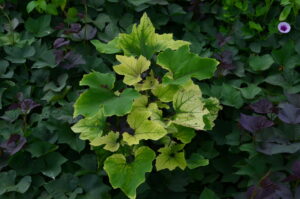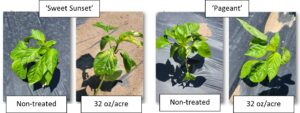Command® 3ME herbicide recently received a 24C Special Local Need label for use in banana peppers in the state of Indiana (Figure 1). Prior to this registration, Command® 3ME could be applied in the production of other types of bell and non-bell peppers, but not banana peppers. Field research results by the Horticulture Crops Weed Science Lab at Purdue University in 2022 were used to create the ‘Directions for Use’ of the new label, which was developed in collaboration with the Office of the Indiana State Chemist and FMC Corporation. This article will address some of the questions related to this newly registered use.
What is Command® 3ME?
Command® 3ME is a soil-applied, pre-emergence herbicide that provides residual weed control of certain grass and broadleaf weeds. It is especially helpful in managing common lambsquarters, foxtails, and velvetleaf but must be applied to a weed-free soil surface for best results.
The “3” in “3ME” refers to the amount of active ingredient in the formulated product (3 pounds per gallon). “ME” refers to the product formulation (microencapsulated). This formulation is designed to result in less off-target herbicide injury than older formulations.
The active ingredient in Command® 3ME is clomazone. Clomazone is a Group 13 herbicide. Clomazone inhibits the production of plant pigments, resulting in white leaf tissues in some plants. In susceptible seedlings, this injury transitions to necrotic (dead) tissue and seedling death. In some larger weeds and crops, the bleaching symptom appears between veins (Figure 2).

Figure 2. Clomazone bleaching injury on cocklebur in a sweet potato field (Photo by Stephen Meyers).
What is a 24C registration?
“24(c)” refers to the section of the Federal Insecticide, Fungicide, and Rodenticide Act (FIFRA) that allows states to register additional uses of federally registered pesticides to meet a local need within their state. In order to qualify, a pesticide must have a documented local need and established pesticide residue tolerances. More information on this process is available here: Guidance on FIFRA 24(c) Registrations | US EPA
How can Command® 3ME be used in banana peppers?
- Apply at least one day before transplanting.
- Make a single application in a minimum of 10 gallons of water per acre.
- Modify use rates based on soil texture:
- Coarse textured soils (sand, loamy sand, sandy loam): 10.7-21.3 fl. oz. per acre.
- Medium textured soils (loam, silt, silt loam, sandy clay, sandy clay loam): 21.3-32 fl. oz. per acre.
- Fine textured soils (silty clay, clay loam, silty clay loam, clay): 32-42.7 fl. oz. per acre.
- In plasticulture systems, Command® 3ME should be applied to row middles only.
Where can I find the label?
The Office of the Indiana State Chemist has developed a webpage to host Special Local Need labels: https://oisc.purdue.edu/pesticide/special_state_registrations.html. If you do not have access to the internet, contact your local Purdue University County Extension Educator or chemical sales representative. This update has been added to the Midwest Vegetable Production Guide database (Midwest Vegetable Production Guide (mwveguide.org)) and will appear in the printed 2024 guide.
Additional Notes
In our research plots, we observed differences in leaf whiting injury between ‘Sweet Sunset’ and ‘Pageant’ banana pepper cultivars on sandier soils (Figure 3). However, this bleaching injury was temporary and did not result in reduced yield compared to a non-treated check.

Figure 3. Banana pepper response to Command® 3ME at the Pinney Purdue Ag Center in 2022 (Potos by Jeanine Arana).
As with any new pesticide, we recommend gradual adoption to ensure crop safety in your specific production system.
